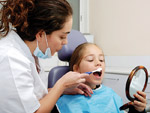Breaking Down Barriers
ADA looks for dental assistant involvement with its initiatives.

In the spirit of widening its focus, The American Dental Association (ADA) has partnered with different stakeholder associations for an upcoming oral health campaign targeted at reaching underserved areas. This program goes hand-in-hand with the ADA’s mission to break down the barriers that keep underserved people from receiving oral care. William R. Calnon, DDS, the newly installed president of the ADA, believes that the involvement of dental assistants is integral to spreading the ADA’s message and accomplishing these goals.
One way to improve access to care is by amplifying the role played by dental assistants. “I think that we’re going to find that dental assistants are capable of increasing their treatment capacity and raising delivery of care rates to all kinds of populations,” Calnon says. “Many states are already increasing the education and certification requirements for assistants, but more need to focus on exploring the true potential of assistants as a critical component of the dental team.” Calnon also believes that because of the amount of time they spend with patients, dental assistants are additionally in a great position to deliver oral health education.
“I think that teaching patients on a person-by-person basis is the best way to get our message across,” he says. “Assistants have the opportunity to do this in both a private practice and public health setting. Giving dental assistants more literature on oral healthcare, and access to our new educational materials, can help them to make a difference with their patients, one patient at a time.”
The high-profile educational public service campaign being developed by the Ad Council—the brainchild of many associations working together—is scheduled to launch during the summer of 2012. The 3-year program is aimed at parents and caregivers, urging them to become more involved in their children’s oral health routine. “I think the message is great because it is really trying to change behavior,” says Calnon, who describes the project as an enormous step toward treating children who live in underserved areas. “We want to stress that dental disease is preventable,” he adds. “We are educating caregivers and parents that it’s time for them to take charge of their children’s oral health, because monitoring their childrencan help prevent disease.”
The idea of an oral health promotional campaign was a key topic when the ADA convened the National Roundtable on Dental Collaboration, a gathering of 22 different stakeholder associations working together to achieve common oral health goals. “As a result of that meeting we all came together to create the Partnership for Healthy Mouths, Healthy Lives,” Calnon explains. “This group really wanted to do something concrete.”
The success of the Healthy Mouths, Healthy Lives coalition will demonstrate that it is often more effective to work cohesively than alone. Calnon is looking forward to working with the organizations and individuals who will aid in making positive steps toward reducing dental disease. “We need a comprehensive approach when breaking down the full spectrum of barriers that prevent and hinder Americans from accessing good oral care,” he says. “There’s a big world out there, we are all in this together. There are a number of issues—such as workforce models, the safety net, prevention, proper funding, and oral health literacy— which need to be addressed. Most critically, the public does not yet understand the distinct correlation between oral health and overall health. We need to get that message out there.”



